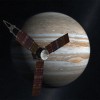NASA’s Juno Satellite vs. Jupiter’s Magnetic Field
Named for the Roman king of the Gods, Jupiter is the largest planet in the solar system and is known for its giant red spot--a raging storm four times as wide as Earth. Jupiter is a gas giant and resides 601 million miles away. Since it was discovered by Galileo in 1610, we’ve learned little about this mysterious planet. That may be about to change.
By now you may have heard that the Juno satellite reached its destination of the gas giant Jupiter earlier last month. This was no easy feat. NASA launched Juno on August 5th, 2011 and after almost exactly five years, the satellite finally arrived. Juno’s mission is to assess how much water exists on our solar system’s largest planet as well as what type of gases make up its atmosphere. In addition to these assignments, Juno will also study Jupiter’s magnetosphere and poles--especially its stunning auroras!
However, this is easier said than done. Jupiter’s magnetic field is much stronger than Earth’s--a result of interplanetary solar winds colliding with the magnetism Jupiter emits. In fact, Jupiter’s magnetic field is the largest structure in the entire solar system! The electromagnetic pulse it emits could easily render any man-made electronics useless. So how did NASA scientists overcome this enormous obstacle?
Juno had to go to sleep. Like sitting in the back seat on a long car trip, Juno powered down most of its vital machinery thousands of miles before entering Jupiter’s magnetic field. This ensured that the there was less a chance of anything be damaged or completely wiped out by Jupiter’s immense power. The only instrument still active was a star tracker to help Juno navigate.
Doing this had NASA scientists holding their breath. The Juno satellite was essentially soaring blindly through Jupiter’s outer atmosphere. To protect its instruments even further, most of Juno’s onboard technology was surrounded by 400 lbs. of pure titanium.
To make matters worse, while Juno was blindly flying toward Jupiter, NASA scientists were essentially deaf to what was happening. One of the ways Juno communicates with NASA is through a series of tones that alert scientists to what the satellite is experiencing. However, due to the immense distance from Earth, it takes Juno’s sounds around 45 minutes to reach NASA!
Despite all of this, Juno made it safely through Jupiter’s immense magnetic fields with all of its machinery intact. Now that the satellite is in orbit, it will circle Jupiter for 20 months, or 37 full orbits, finishing its mission in February 2018. After that, Juno will leave Jupiter’s orbit and eventually fall into the swirling atmosphere of the planet.

